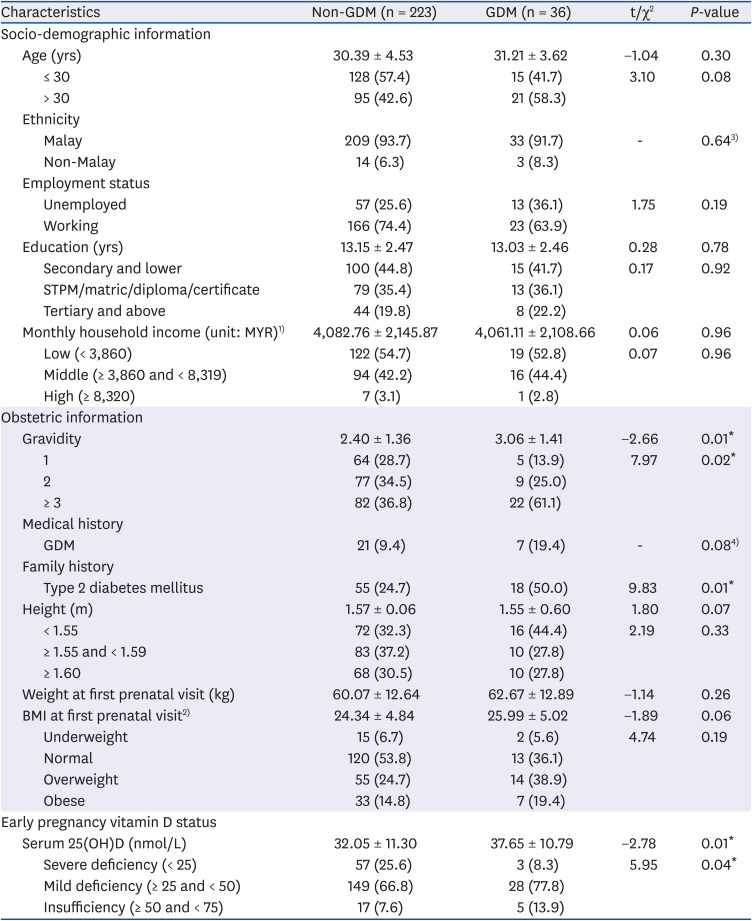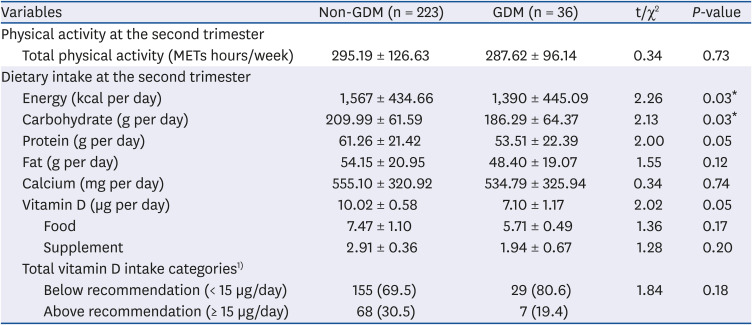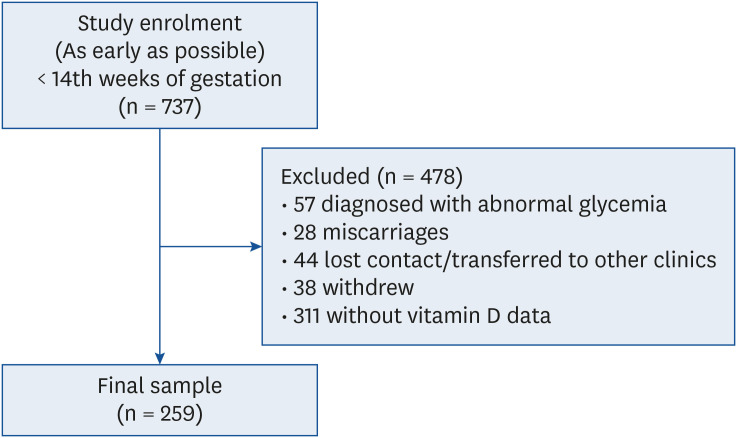1. Lips P, Eekhoff M, van Schoor N, Oosterwerff M, de Jongh R, Krul-Poel Y, Simsek S. Vitamin D and type 2 diabetes. J Steroid Biochem Mol Biol. 2017; 173:280–285. PMID:
27932304.

2. Issa CM. Vitamin D and type 2 diabetes mellitus. Adv Exp Med Biol. 2017; 996:193–205. PMID:
29124701.

3. Pittas AG, Lau J, Hu FB, Dawson-Hughes B. The role of vitamin D and calcium in type 2 diabetes. A systematic review and meta-analysis. J Clin Endocrinol Metab. 2007; 92:2017–2029. PMID:
17389701.

4. Park S, Yoon HK, Ryu HM, Han YJ, Lee SW, Park BK, Park SY, Yim CH, Kim SH. Maternal vitamin D deficiency in early pregnancy is not associated with gestational diabetes mellitus development or pregnancy outcomes in Korean pregnant women in a prospective study. J Nutr Sci Vitaminol (Tokyo). 2014; 60:269–275. PMID:
25297616.

5. Baker AM, Haeri S, Camargo CA Jr, Stuebe AM, Boggess KA. First-trimester maternal vitamin D status and risk for gestational diabetes (GDM) a nested case-control study. Diabetes Metab Res Rev. 2012; 28:164–168. PMID:
21818838.

6. Loy SL, Lek N, Yap F, Soh SE, Padmapriya N, Tan KH, Biswas A, Yeo GS, Kwek K, Gluckman PD, et al. Association of maternal Vitamin D status with glucose tolerance and caesarean section in a multi-ethnic Asian cohort: the growing up in Singapore towards healthy outcomes study. PLoS One. 2015; 10:e0142239. PMID:
26571128.

7. Rodriguez A, García-Esteban R, Basterretxea M, Lertxundi A, Rodríguez-Bernal C, Iñiguez C, Rodriguez-Dehli C, Tardón A, Espada M, Sunyer J, et al. Associations of maternal circulating 25-hydroxyvitamin D3 concentration with pregnancy and birth outcomes. BJOG. 2015; 122:1695–1704. PMID:
25208685.

8. Hauta-Alus HH, Viljakainen HT, Holmlund-Suila EM, Enlund-Cerullo M, Rosendahl J, Valkama SM, Helve OM, Hytinantti TK, Mäkitie OM, Andersson S. Maternal vitamin D status, gestational diabetes and infant birth size. BMC Pregnancy Childbirth. 2017; 17:420–429. PMID:
29246128.

9. Lacroix M, Battista MC, Doyon M, Houde G, Ménard J, Ardilouze JL, Hivert MF, Perron P. Lower vitamin D levels at first trimester are associated with higher risk of developing gestational diabetes mellitus. Acta Diabetol. 2014; 51:609–616. PMID:
24526261.

10. Al-Ajlan A, Al-Musharaf S, Fouda MA, Krishnaswamy S, Wani K, Aljohani NJ, Al-Serehi A, Sheshah E, Alshingetti NM, Turkistani IZ, et al. Lower vitamin D levels in Saudi pregnant women are associated with higher risk of developing GDM. BMC Pregnancy Childbirth. 2018; 18:86–93. PMID:
29631547.

11. Wang O, Nie M, Hu YY, Zhang K, Li W, Ping F, Liu JT, Chen LM, Xing XP. Association between vitamin D insufficiency and the risk for gestational diabetes mellitus in pregnant Chinese women. Biomed Environ Sci. 2012; 25:399–406. PMID:
23026519.
12. Xu C, Ma HH, Wang Y. Maternal early pregnancy plasma concentration of 25-hydroxyvitamin D and risk of gestational diabetes mellitus. Calcif Tissue Int. 2018; 102:280–286. PMID:
29058058.

13. Arnold DL, Enquobahrie DA, Qiu C, Huang J, Grote N, VanderStoep A, Williams MA. Early pregnancy maternal vitamin D concentrations and risk of gestational diabetes mellitus. Paediatr Perinat Epidemiol. 2015; 29:200–210. PMID:
25808081.

14. Poel YH, Hummel P, Lips P, Stam F, van der Ploeg T, Simsek S. Vitamin D and gestational diabetes: a systematic review and meta-analysis. Eur J Intern Med. 2012; 23:465–469. PMID:
22726378.

15. Wei SQ, Qi HP, Luo ZC, Fraser WD. Maternal vitamin D status and adverse pregnancy outcomes: a systematic review and meta-analysis. J Matern Fetal Neonatal Med. 2013; 26:889–899. PMID:
23311886.

16. Burris HH, Rifas-Shiman SL, Kleinman K, Litonjua AA, Huh SY, Rich-Edwards JW, Camargo CA Jr, Gillman MW. Vitamin D deficiency in pregnancy and gestational diabetes mellitus. Am J Obstet Gynecol. 2012; 207:182.e1–182.e8. PMID:
22717271.

17. Alvarez JA, Ashraf A. Role of vitamin d in insulin secretion and insulin sensitivity for glucose homeostasis. Int J Endocrinol. 2010; 2010:351385. PMID:
20011094.

18. Sung CC, Liao MT, Lu KC, Wu CC. Role of vitamin D in insulin resistance. J Biomed Biotechnol. 2012; 2012:634195. PMID:
22988423.

19. Evans KN, Bulmer JN, Kilby MD, Hewison M. Vitamin D and placental-decidual function. J Soc Gynecol Investig. 2004; 11:263–271.

20. Eguchi K, Nagai R. Islet inflammation in type 2 diabetes and physiology. J Clin Invest. 2017; 127:14–23. PMID:
28045399.

21. Szymczak-Pajor I, Drzewoski J, Śliwińska A. The molecular mechanisms by which vitamin D prevents insulin resistance and associated disorders. Int J Mol Sci. 2020; 21:6644.

22. Prietl B, Treiber G, Pieber TR, Amrein K. Vitamin D and immune function. Nutrients. 2013; 5:2502–2521. PMID:
23857223.

23. Charoenngam N, Holick MF. Immunologic effects of vitamin D on human health and disease. Nutrients. 2020; 12:2097.

25. Jeganathan R, Karalasingam SD. National Obstetrics Registry: 5th Report, Jan 2016–Dec 2017 [Internet]. Selangor Darul Ehsan: Jointly published by the National Obstetrics Registry and the Institute Clinical Research (IRC), Ministry of Health Malaysia;2020. cited 2020 May 1. Available from:
http://www.acrm.org.my/nor/doc/reports/5th_NOR_Report.pdf.
26. Jeganathan R, Karalasingam SD. Preliminary Report of National Obstetrics Registry, Jan–December 2010. Kuala Lumpur: Jointly published by the National Obstetrics Registry and the Clinical Research Centre (CRC), Ministry of Health Malaysia;2013.
27. Logakodie S, Azahadi O, Fuziah P, Norizzati B, Tan SF, Zienna Z, Norliza M, Noraini J, Hazlin M, Noraliza MZ, et al. Gestational diabetes mellitus: the prevalence, associated factors and foeto-maternal outcome of women attending antenatal care. Malays Fam Physician. 2017; 12:9–17. PMID:
29423124.
28. Tan PC, Ling LP, Omar SZ. Screening for gestational diabetes at antenatal booking in a Malaysian university hospital: the role of risk factors and threshold value for the 50-g glucose challenge test. Aust N Z J Obstet Gynaecol. 2007; 47:191–197. PMID:
17550485.

29. Jan Mohamed HJ, Rowan A, Fong B, Loy SL. Maternal serum and breast milk vitamin D levels: findings from the Universiti Sains Malaysia Pregnancy Cohort Study. PLoS One. 2014; 9:e100705. PMID:
24992199.

30. Bukhary NB, Isa ZM, Shamsuddin K, Lin KG, Mahdy ZA, Hassan H, Yeop NS. Risk factors for antenatal hypovitaminosis D in an urban district in Malaysia. BMC Pregnancy Childbirth. 2016; 16:156–166. PMID:
27411716.

31. Mousa A, Abell SK, Shorakae S, Harrison CL, Naderpoor N, Hiam D, Moreno-Asso A, Stepto NK, Teede HJ, de Courten B. Relationship between vitamin D and gestational diabetes in overweight or obese pregnant women may be mediated by adiponectin. Mol Nutr Food Res. 2017; 61:1700488.

32. Yong HY, Mohd Shariff Z, Rejali Z, Mohd Yusof BN, Yasmin F, Palaniveloo L. Seremban Cohort Study (SECOST): a prospective study of determinants and pregnancy outcomes of maternal glycaemia in Malaysia. BMJ Open. 2018; 8:e018321.

33. Palaniveloo L, Yong HY, Mohd Shariff Z, Loh SP, Bindels J, Tee YY, van der Beek EM. Vitamin D status is associated with high BMI, working status and gravidity among pregnant Malaysian women. Malays J Nutr. 2020; 26:129–139.

34. Institute of Medicine. Dietary Reference Intakes for Calcium and Vitamin D. Washington, D.C.: The National Academies Press;2011.
36. Obesity: preventing and managing the global epidemic. Report of a WHO consultation. World Health Organ Tech Rep Ser. 2000; 894:i–ixii. 1–253. PMID:
11234459.
37. First DataBank. Nutritionist Pro. San Bruno (CA): First DataBank;2005.
38. U.S. Department of Agriculture, Agricultural Research Service, Beltsville Human Nutrition Research Center, Nutrient Data Laboratory. USDA National Nutrient Database for Standard Reference, Release 28. Beltsville (MD): Nutrient Data Laboratory;2016.
39. Ministry of Health Malaysia, National Coordinating Committee on Food and Nutrition (NCCFN). Recommended Nutrient Intakes for Malaysia: A Report of the Technical Working Group on Nutritional Guidelines. Putrajaya: Ministry of Health Malaysia;2017.
40. Chasan-Taber L, Schmidt MD, Roberts DE, Hosmer D, Markenson G, Freedson PS. Development and validation of a Pregnancy Physical Activity Questionnaire. Med Sci Sports Exerc. 2004; 36:1750–1760. PMID:
15595297.

41. IBM Corp. IBM SPSS Statistics 25.0 for Windows, Released 2020. Armonk (NY): IBM Corp.;2020.
42. Szumilas M. Explaining odds ratios. J Can Acad Child Adolesc Psychiatry. 2010; 19:227–229. PMID:
20842279.
43. Chiefari E, Arcidiacono B, Foti D, Brunetti A. Gestational diabetes mellitus: an updated overview. J Endocrinol Invest. 2017; 40:899–909. PMID:
28283913.

44. Cozzolino M, Serena C, Maggio L, Rambaldi MP, Simeone S, Mello G, Pasquini L, Di Tommaso M, Mecacci F. Analysis of the main risk factors for gestational diabetes diagnosed with International Association of Diabetes and Pregnancy Study Groups (IADPSG) criteria in multiple pregnancies. J Endocrinol Invest. 2017; 40:937–943. PMID:
28324453.

45. Yang X, Hsu-Hage B, Zhang H, Yu L, Dong L, Li J, Shao P, Zhang C. Gestational diabetes mellitus in women of single gravidity in Tianjin City, China. Diabetes Care. 2002; 25:847–851. PMID:
11978679.

46. Yang H, Wei Y, Gao X, Xu X, Fan L, He J, Hu Y, Liu X, Chen X, Yang Z, et al. Risk factors for gestational diabetes mellitus in Chinese women: a prospective study of 16,286 pregnant women in China. Diabet Med. 2009; 26:1099–1104. PMID:
19929987.
47. Di Cianni G, Volpe L, Lencioni C, Miccoli R, Cuccuru I, Ghio A, Chatzianagnostou K, Bottone P, Teti G, Del Prato S, et al. Prevalence and risk factors for gestational diabetes assessed by universal screening. Diabetes Res Clin Pract. 2003; 62:131–137. PMID:
14581150.

48. Erem C, Kuzu UB, Deger O, Can G. Prevalence of gestational diabetes mellitus and associated risk factors in Turkish women: the Trabzon GDM Study. Arch Med Sci. 2015; 11:724–735. PMID:
26322083.
49. Castro AV, Kolka CM, Kim SP, Bergman RN. Obesity, insulin resistance and comorbidities? Mechanisms of association. Arq Bras Endocrinol Metabol. 2014; 58:600–609. PMID:
25211442.
50. Kwak SH, Kim SH, Cho YM, Go MJ, Cho YS, Choi SH, Moon MK, Jung HS, Shin HD, Kang HM, et al. A genome-wide association study of gestational diabetes mellitus in Korean women. Diabetes. 2012; 61:531–541. PMID:
22233651.

51. Flood-Nichols SK, Tinnemore D, Huang RR, Napolitano PG, Ippolito DL. Vitamin D deficiency in early pregnancy. PLoS One. 2015; 10:e0123763. PMID:
25898021.

52. Pérez-López FR, Fernández-Alonso AM, Ferrando-Marco P, González-Salmerón MD, Dionis-Sánchez EC, Fiol-Ruiz G, Chedraui P. First trimester serum 25-hydroxyvitamin D status and factors related to lower levels in gravids living in the Spanish Mediterranean coast. Reprod Sci. 2011; 18:730–736. PMID:
21285449.

53. Leffelaar ER, Vrijkotte TG, van Eijsden M. Maternal early pregnancy vitamin D status in relation to fetal and neonatal growth: results of the multi-ethnic Amsterdam Born Children and their Development cohort. Br J Nutr. 2010; 104:108–117. PMID:
20193097.

54. Ates S, Sevket O, Ozcan P, Ozkal F, Kaya MO, Dane B. Vitamin D status in the first-trimester: effects of vitamin D deficiency on pregnancy outcomes. Afr Health Sci. 2016; 16:36–43. PMID:
27358611.

55. Song SJ, Zhou L, Si S, Liu J, Zhou J, Feng K, Wu J, Zhang W. The high prevalence of vitamin D deficiency and its related maternal factors in pregnant women in Beijing. PLoS One. 2013; 8:e85081. PMID:
24386450.

56. Holick MF, Binkley NC, Bischoff-Ferrari HA, Gordon CM, Hanley DA, Heaney RP, Murad MH, Weaver CM; Endocrine Society. Evaluation, treatment, and prevention of vitamin D deficiency: an Endocrine Society clinical practice guideline. J Clin Endocrinol Metab. 2011; 96:1911–1930. PMID:
21646368.

57. Yong HY, Zalilah MS, Tan CW, Koo SJ. Pre-pregnancy BMI and intake of energy and calcium are associated with the vitamin D intake of pregnant Malaysian women. Fam Med Prim Care Rev. 2017; 19:417–423.

58. Huang TT, Roberts SB, Howarth NC, McCrory MA. Effect of screening out implausible energy intake reports on relationships between diet and BMI. Obes Res. 2005; 13:1205–1217. PMID:
16076990.










 PDF
PDF Citation
Citation Print
Print




 XML Download
XML Download